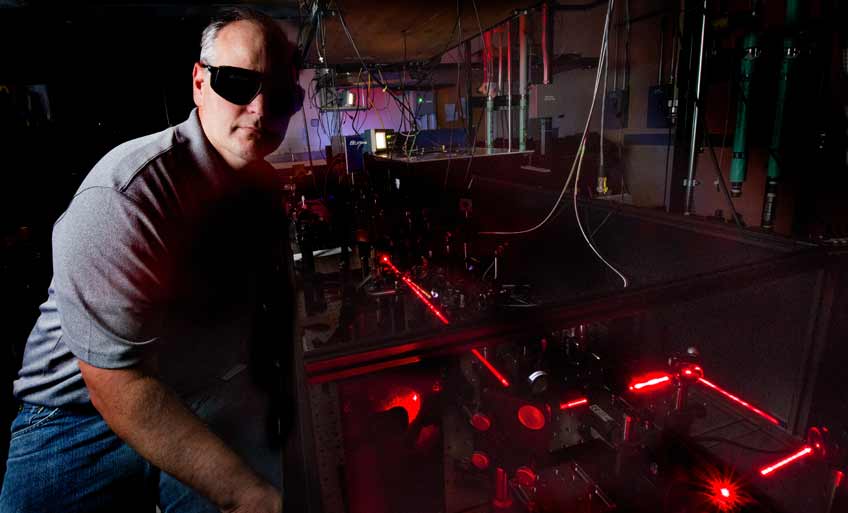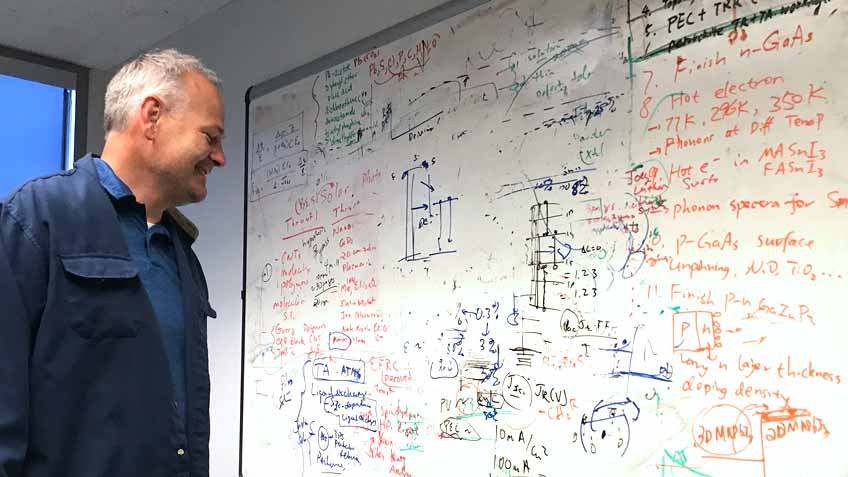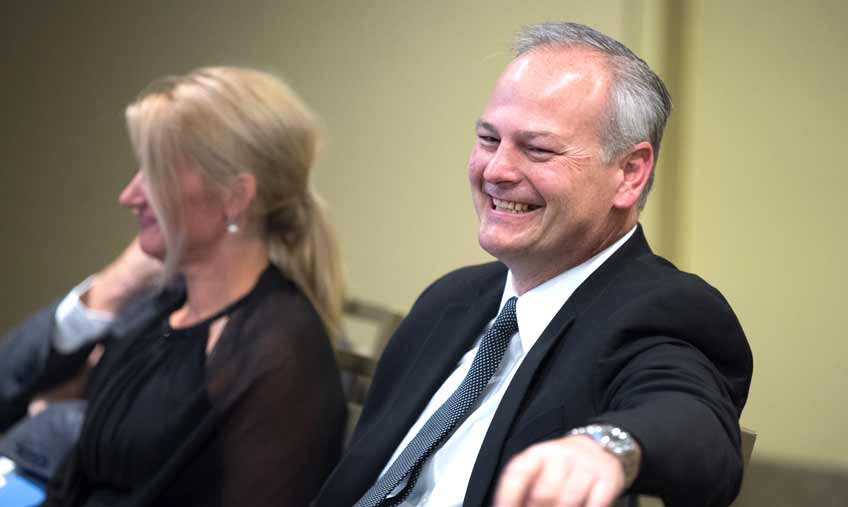Matt Beard: New Senior Research Fellow Helps Make Quantum Leap in Solar Energy

Newly appointed National Renewable Energy Laboratory (NREL) Senior Research Fellow Matt Beard has 4-year-old squiggles on his office whiteboard. It’s not that the chemist is sloppy. He’s just mildly irritated.
He and his NREL team had embarked on a complicated synthesis of 5-nanometer-diameter lead sulfide nanostructures. They were trying to create a nanoplatelet of the material. Instead, they made something different—probably because of an impurity in one of the reagents, the mixtures used in chemical analyses.
“We had this mystery compound that we didn’t intend to make,” Beard said. “So, we were listing all the reagents on the whiteboard that went into the synthesis, trying to figure out what it could be.”
But they failed and finally decided the pursuit was “a rabbit hole”—not exactly a scientific term, but close enough.
“I’m still bugged that we can’t solve this,” he said. As a result, he hasn’t erased the notes, which taunt him daily.
“It’s one of those things that if all the other projects we’re doing die down a little bit, we’ll go back,” he said.
Despite earlier this year receiving an honor from the Royal Society of Chemistry, the oldest chemical society in the world, Beard is not what most people would think of as a typical chemist. He doesn’t usually make compounds. Instead, he measures processes and develops nanomaterials. Such basic science—looking at the foundations of materials that someday could translate into renewable energy sources—is central to his investigations. And while he is extremely precise, he is also realistic.
“Sometimes you do things by accident, and it’s great,” he said. “Other times…” His voice trailed off.
Beard is used to pondering unknowns. He directs the Center for Hybrid Organic Inorganic Semiconductors for Energy (CHOISE), an Energy Frontier Research Center funded by the U.S. Department of Energy's Office of Science. For the past year, he’s led about 40 researchers in some 15 institutions to further CHOISE’s mission: to accelerate the discovery of, and explain design principles for, unprecedented control over emergent properties involving electron spin, charge, and light-matter interactions—an “emerging” field.
“We’re trying to develop whole new concepts that can impact all sorts of different energy technologies—not just solar cells,” he said. “We’re looking at things beyond PV [photovoltaics], such as spin-based technologies, or ‘spintronics.’”
As Beard explained, “Most devices usually rely on charge—an electron has a negative charge, and a hole has a positive charge. You want to separate charges and move them about.” Yet, electrons also have spin, a “magnetic component,” he said.
“We want to understand, within our material set, how to control and manipulate spin for different types of applications.” Light emission is one possible usage, but the inquiry is too new to predict what technologies could potentially benefit. “We’re still developing the science of this. Ultimately, there could be all sorts of spin-based technologies. [Everything] depends on how you design materials.”
If Beard seems on a quest into unexplored places, it may be partly due to an encounter he had with another NREL pioneer in photoelectrochemistry, Senior Research Fellow Emeritus Art Nozik.

While getting his Ph.D. in physical chemistry at Yale University, Beard was part of a group that developed a new type of ultrafast spectroscopy. In his final year there, Beard attended a presentation by Nozik.
“I was impressed by his message about renewable energy,” Beard said. Nozik, for his part, was struck by Beard’s innovative skills. After Beard earned his doctorate 15 years ago, Nozik invited him to join NREL as a postdoctoral fellow.
“I’ve been working with Art since then,” Beard said. “He’s a fantastic scientist and person.”
Nozik returns the praise. “He’s quiet and reserved, but rigorous, creative, and productive.”
Nozik was an early investigator of quantum dots, and Beard became a strong ally. The two teamed up in an array of research, such as the study of semiconductor nanostructures. A paper they co-authored in 2004 about multiple exciton generation—which involves the generation of more than one electron-hole pair (an exciton) from the absorption of a single packet of light energy (a photon)—has been cited several thousand times.
Beard admires the early renewable energy leaders, such as Nozik and NREL Senior Fellow Dave Ginley.
“With Art, a great challenge is trying to push the limits of solar energy conversion efficiency,” Beard said. “He and his peers are unique in that, in the early 1970s, there was a grand energy challenge that attracted a lot of people. After that, though, there was an oil boom, and a lot of people moved away from renewable energy research.”
Nozik, among others, kept the lights on in the field. And, in a sense, he passed that torch to Beard. When an earlier Energy Frontier Research Center—the Center for Advanced Solar Photophysics (CASP)—formed in 2009, Nozik was one of its leaders. When he became emeritus, Beard moved up and was active until CASP concluded its work in 2018.
His collaborative spirit and inquisitive mind have inspired his colleagues.
“I am always impressed with the breadth of knowledge that Matt has,” said researcher Joey Luther. “He knows more subjects of science in greater depth than nearly anyone else at the laboratory. I assume this is because he is so capable of learning new subjects. I often find out that, in a very short period of time, he has found, read, and absorbed all the papers pertaining to some different field of research. It’s simply amazing.”

A Scientist at Home at NREL
Beard met his wife Alyssa while they were undergraduates at Brigham Young University. There, Beard learned how to perform adiabatic low-temperature calorimetry.
“It was kind of interesting—but also boring,” he laughed. “I learned how to make measurements carefully. You had to account for every little thing you did to get the answer you needed—measuring humidity, the weight of samples, and more. It taught me a lot.”
While Beard is modest about the amount of work he’s published, it has had an impact. He, along with Nozik and three other NREL scientists, were named to the 2018 list of Highly Cited International Researchers—something achieved by only 1% of scientists globally in each of the list's categories. He’s reserved about the accomplishment.
“You want to make an impact, not just be published,” he said.
Sometimes, his impact is felt at his dinner table. Beard’s wife is a geohydrologist working on environmental issues for the oil and gas industry, and they often “talk shop” during dinner.
“Of course, she understands the need for renewable energy,” he said. The couple’s 17-year-old has not yet expressed a strong interest in science, “but that could change.”
Meanwhile, Beard—who said he probably works too much—remains pleased to be at NREL.
“There’s the science and then there’s the technology of solar energy,” he said. “NREL has done a great job of leading in both of these areas.” So far, Beard has played a major role, but also sees many challenges ahead to tackle.
And if things slow down a bit … there’s always that messy white board to work on.
Last Updated May 28, 2025
